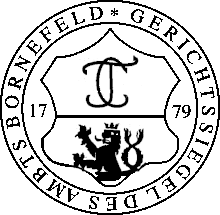Bornefeld Office
The Bornefeld office already existed when the office of Blankenberg was transferred to the Duchy of Berg in 1363. A Bornefeld judicial district under the name "in judicio sine officio de Burlevelt" was recorded as early as 1270.
The office included the area around today's city of Wermelskirchen , the parish of Lüttringhausen (until 1407), Hückeswagen (from 1555), Dhünn , Remscheid and Dabringhausen . The place Lennep already had city rights and its own jurisdiction, so it was not part of the office. To the south bordered the office Steinbach , to the west the office Miselohe and the office Solingen , later in the northeast from approx. 1380 the office Beyenburg , into which Lüttringhausen was transferred, and finally in the northwest the office Elberfeld .
The official seat is said to have been initially Lennep , later today's Bergisch Born . Bornefeld , in a central location, is therefore probably also the seat of the judicial district, also known as Vest , first mentioned in 1270 , from which the office emerged. Documents show that the administrative seat of the office moved to Wermelskirchen in the 15th century, where the Galgenplatz was demonstrably until 1789 .
In 1555 it was administratively combined with the Hückeswagen Office and has been called the Bornefeld-Hückeswagen Office since then . House Nagelsgaul near Wipperfürth was the residence of the noble bailiffs from the von Nagel family for several generations. The seat of the judge was Hückeswagen Castle until 1812 . The seat of the administrators, last provided by Carl Philipp von Schatte until 1812 , was Wermelskirchen.
The court of the Bornefeld district
A special feature for the Bornefeld office was the stipulation that 24 lay judges from other courts or other offices had to be consulted if no decision could be made on open legal issues. For the Bornefeld office, these were the offices of Miselohe and Steinbach. The legal move went via Wermelskirchen to Dabringhausen, from there to the ducal chamber at Burg Castle . The meetings of the court took place alternately in Wermelskirchen and Hückeswagen or in different places in the district, often in the "Linde" in Remscheid or in the "Jägerhaus" in Bergisch Born.
The mathematician and geographer Erich Philipp Ploennies wrote in his topographical work on the areas of Solingen and Remscheid in 1715:
“... that here 'most of the residents ... are tradespeople and merchants',' that is why you see so much werckstädt (n) in the same place, so much grinders, hammers ... and forges; sintemahl in this office most of the iron ware (s) of swords, knives ... and other things are made ... and sent to foreign countries'. "
Bailiffs
The following officials are documented:
- 1365: Bruno von Garath, amptman in the vesten van Bornfeldt
- 1385: Karselis Brachger, kelner zor Burgh ind amptman zu Bernevelde
literature
- Albrecht Brendler: On the way to the territory. Administrative structure and office holder of the County of Berg 1225–1380 . Inaugural dissertation, Bonn 2015, pp. 143–150.
Individual evidence
- ^ Historical archive of the city of Cologne, Groß St. Martin, Rep. U. HS No. 3, f. 55V. Copy in: NJBreidenbach, private collection sources & materials, vol. 78, 1993
- ↑ A. Kolodziej: Duke Wilhelm I von Berg (1380-1408) . Neustadt adA 2005, ISBN 3-87707-639-4 , p. 208.
- ↑ J. v. Lülsdorf: On the development of state sovereignty in the individual parts of the Duchy of Berg , magazine of the Bergisches Geschichts-Verein, vol. 70, Wuppertal 1949, pp. 253-318.
- ^ NJ Breidenbach: The court in Wermelskirchen, Hückeswagen and Remscheid from 1639 to 1812, texts and reports from the court minutes and official files of Bornefeld-Hückeswagen . Verlag Gisela Breidenbach, Wermelskirchen 2005, ISBN 3-980-2801-5-2 .
- ↑ Brendler (2015), p. 150.
Coordinates: 51 ° 9 ′ N , 7 ° 16 ′ E



